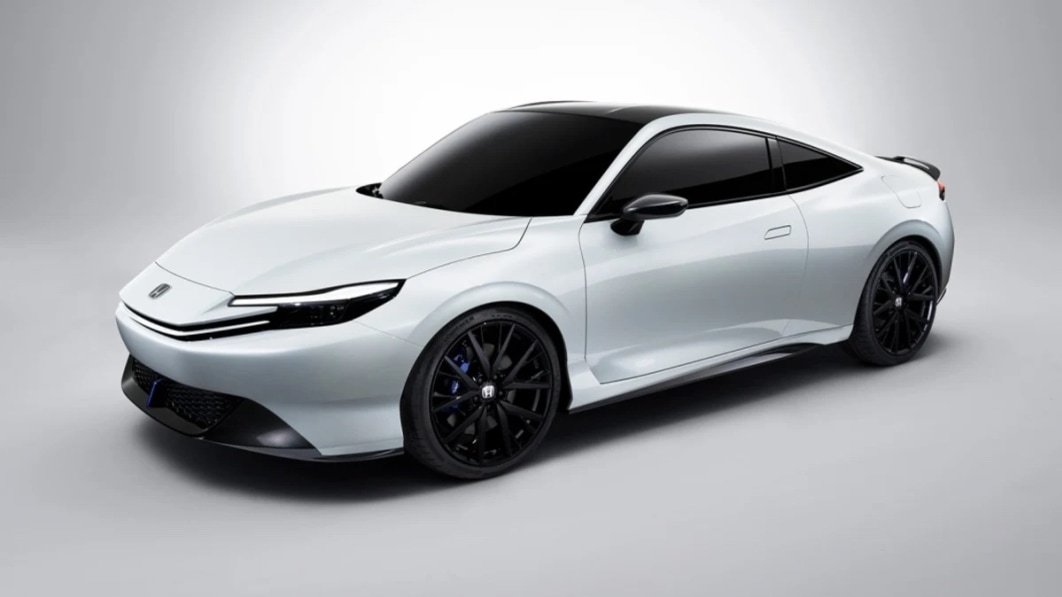2024 Kia EV9 boasts Telluride appeal with EV efficiency
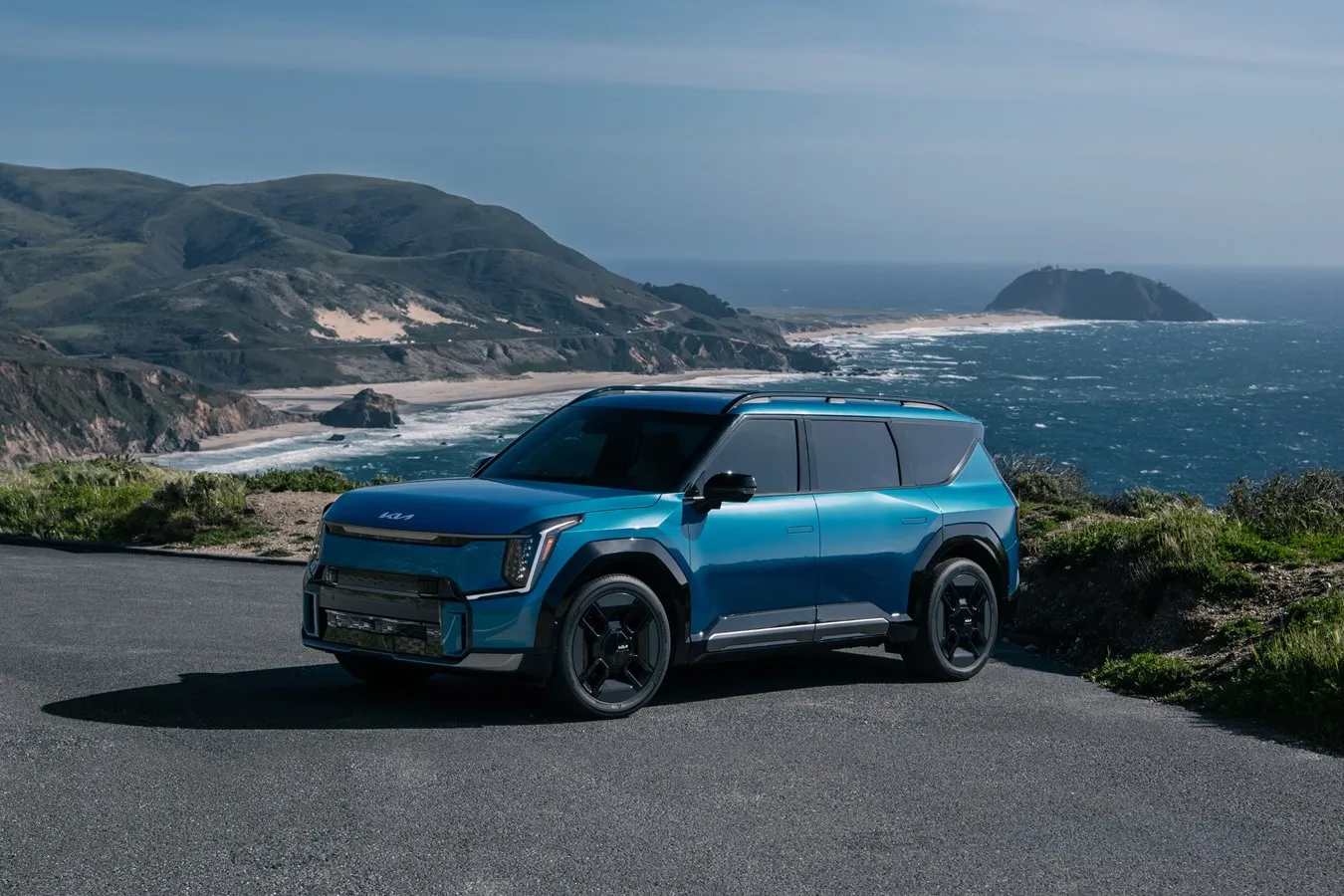
Kia captured the hearts and pocketbooks of American families when it released the gas-powered Telluride three-row SUV in 2019. Leading with alluring looks and backed by a premium feel, the Telluride been the brand’s third-best seller and sales have only increased every year since its launch. Now, Kia is following the same formula with the 2024 EV9, a three-row SUV with similar strengths to go with an electric powertrain.
The EV9 is set to go on sale later this year, but The Car Connection got an early drive in prototype models at Kia’s proving grounds in California’s Mojave Desert. The drive involved four controlled exercises on private roads, and gave us some time alone with the vehicles to check out the EV9’s interior.
Kia will offer the EV9 in four trim levels with single- and dual-motor powertrains and 76.1- or 99.8-kwh battery pack options. The trim levels consist of Light, Wind, Land, and GT Line, and range is estimated to be 223-300 miles, depending on the model and wheels and tires.
For our drive, Kia provided only the top trim, the GT Line, which comes with the big battery and the dual-motor powertrain tuned to 379 hp and 516 lb-ft of torque. While the drive didn’t involve any public roads, the range of driving conditions showed much of what buyers can expect from the attractive three-row EV.
2024 Kia EV9
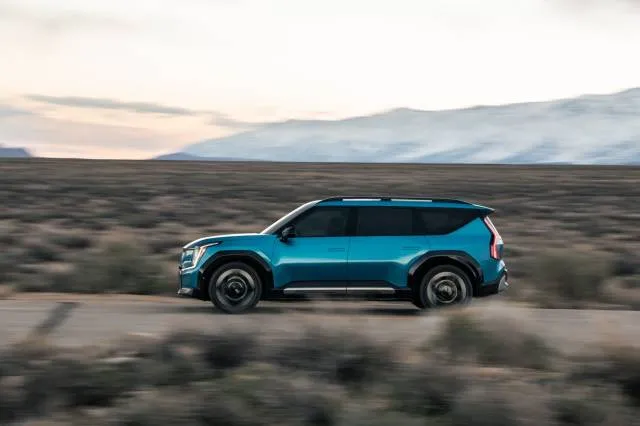
2024 Kia EV9
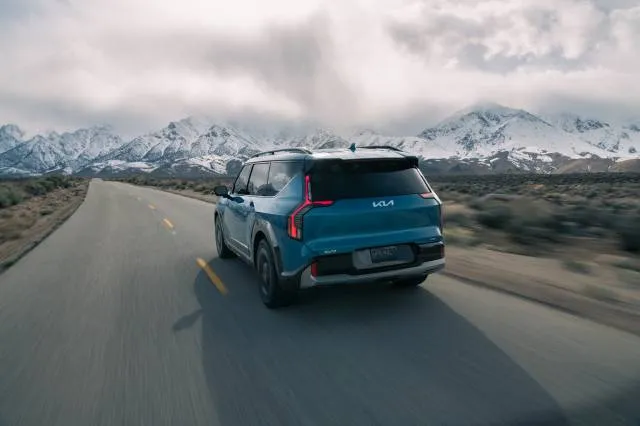
2024 Kia EV9
2024 Kia EV9: High-speed oval
The first exercise involved a few laps around the proving grounds’ 6.4-mile high-speed oval. It provided a feel for the ride quality, which is predictably forgiving, even over portions of the track built to simulate poor road conditions. It doesn’t feel quite as soft as the Telluride—probably because all the weight it carries down low—but it smooths over most bumps even on the top 21-inch wheels and tires.
It also highlighted some of the EV9’s healthy set of standard safety features, which includes automatic emergency braking with cross-traffic assist and pedestrian detection, active blind-spot monitors, a driver-attention monitor, active lane control, adaptive cruise control, rear cross-traffic emergency braking, front and rear parking sensors, rear seat occupant alerts, and an exit warning system.
This exercise was a test of the active lane control, which Kia further breaks down into lane keeping assist and lane following assist. A lead driver instructed a small group of EV9s to activate the system, and we drove mostly hands-free at speeds up to 110 mph. The system kept the vehicle in its lane, though it prompted me to put my hands on the wheel when my eyes strayed from the road. With 6.4 miles of sprawl-out space, the curves were never too sharp to challenge the system’s ability to stay in its lane.
After launch, Kia will offer an optional Advanced Highway Driving Assist (AHDA) system that will include lidar. If the capability of the standard semi-autonomous driving features we already tested is any indication, this system should challenge GM’s Super Cruise as one of the better options on the market.
Safety options include a surround-view camera system, blind-spot camera displays that activate when a turn signal is used, and automatic parking.
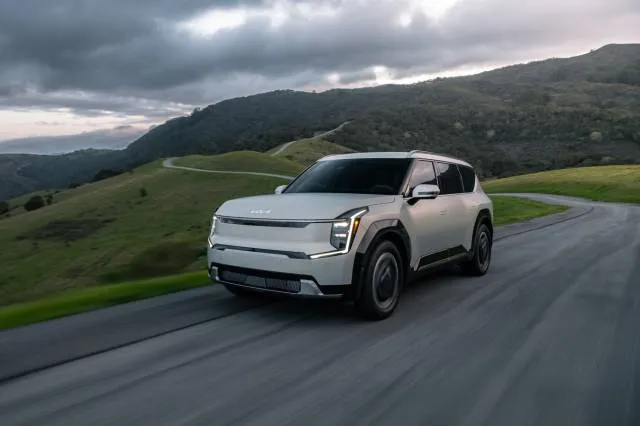
2024 Kia EV9
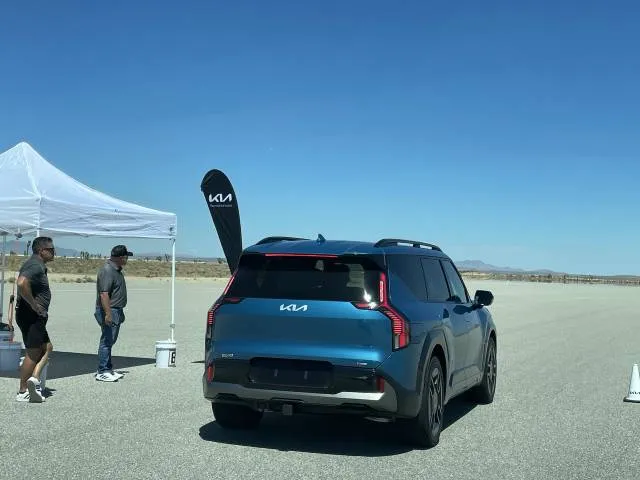
2024 Kia EV9
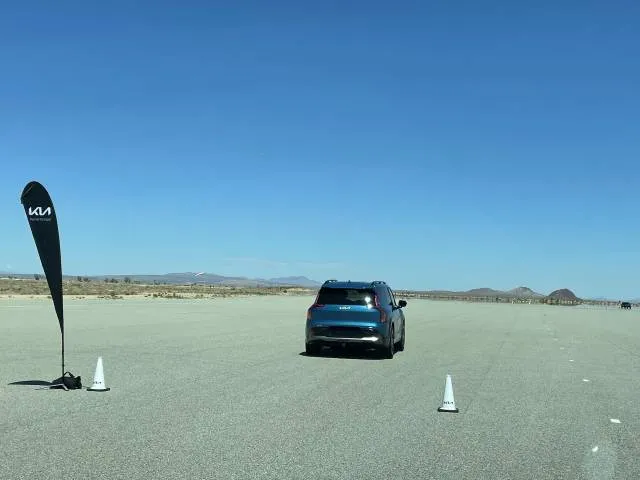
2024 Kia EV9
2024 Kia EV9: Winding road and Vehicle Dynamic Area
Next, we moved on to a small road course, though an autocross on the black lake tarmac that is the Vehicle Dynamics Area shed even more light on the EV9’s driving dynamics.
The EV9 comes with a MacPherson strut front suspension, a five-link independent rear suspension, and passive dampers. That’s pretty standard stuff for a mainstream vehicle, and not the type of equipment that will provide sports car-like moves.
During a restrained lead-follow session on the road course, the EV9 felt reasonably well controlled without too much body lean thanks to the low-set weight of its battery. The steering was direct, not overly quick, and light on feel.
The tighter confines of the autocross showed the EV9’s handling limits. It weighs in at up to 5,886 pounds and rides on all-season tires, in this case a set of 285/45R21 Hankook Ion Evos. That’s a lot of tread on the pavement, and Kia says it can handle up to 0.84 g of lateral grip, which is respectable for an SUV. However, throwing the EV9 into a tight corner easily overcomes the traction and causes the SUV to plow forward rather than turn. There’s no sporty pretense here.
The GT Line’s considerable power is also a detriment to handling more than the same amount of power would be in a gas vehicle. With 379 hp, and more importantly 516 lb-ft of immediately accessed torque, the throttle can easily upset vehicle balance midcorner. It’s much harder to roll onto the throttle at the apex of a turn, and it can give the SUV a jolt of power that raises the front end and only exacerbates the tendency to push rather than rotate. Without the buildup of power that an engine provides, this will be a problem with future EVs, including sporty ones.
My drive on the VDA also included a straight-line acceleration run over a stretch of 1,120 feet, just 200 feet short of a quarter mile. It showed the EV9 GT Line is plenty quick despite its weight.
I first tried launching in Eco mode. The power came on strong but not overwhelmingly so and got the big SUV up to 88 mph by the end of the run. Switching to Sport mode sent a shock through my spine at launch and increased the speed to 98 mph. Surprisingly, so did Normal mode, as full power is available when the driver pins the throttle. Otherwise, Sport mode has an itchier throttle pedal.
The other models have less power. The Light model will come with a single rear motor that makes 215 hp and 258 lb-ft. It’s teamed with a 76.1-kwh battery and is good for an estimated 223 miles of range. Kia says it can accelerate from 0-60 mph in 7.7 seconds.
A Long-Range Light will get 201 hp, 258 lb-ft, and a 99.8-kwh battery to increase range to an estimated 300 miles. Its 0-60 mph time will come in at a pedestrian 8.8 seconds.
The Wind and Land models will have the big battery, front and rear motors for standard all-wheel drive, 379 hp, and 443 lb-ft. They will hit 60 mph in 5.7 seconds, according to Kia. An over-the-air update will be offered to increase torque in these models to the GT Line’s standard 516 lb-ft and cut the 0-60 mph time to just below 5.0 seconds. The GT Line also gets the big battery.
Range will max out at 270 miles for the dual-motor versions with the standard 19-inch wheels, while additional content and larger wheels will cut range down to 243 miles. Dual-motor models will be able to tow 5,000 pounds, while single-motor versions will top out at 2,000 pounds.
Every EV9 uses an 800-volt electrical architecture that can take a DC fast charge. The smaller battery will be able to charge at a rate of 236 kw, while the big battery will top out at a rate of 215 kw. Kia says the first figure will let the EV9 charge from a 10-80% charge in 20 minutes with the small battery and 24 minutes with the big battery.
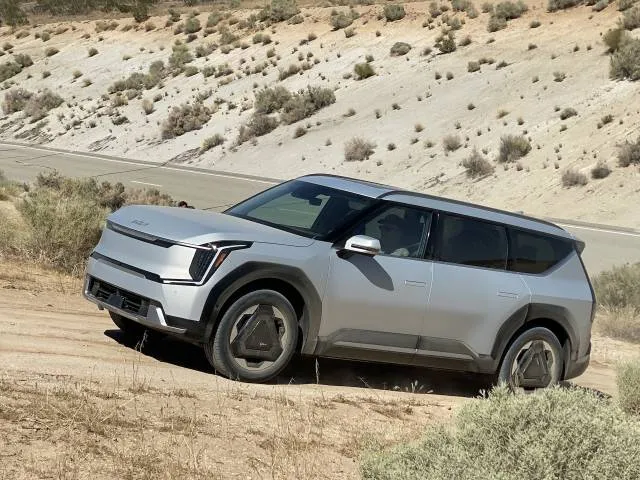
2024 Kia EV9
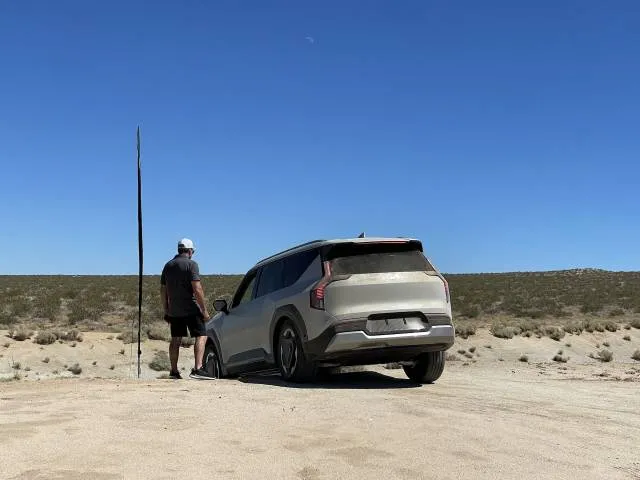
2024 Kia EV9
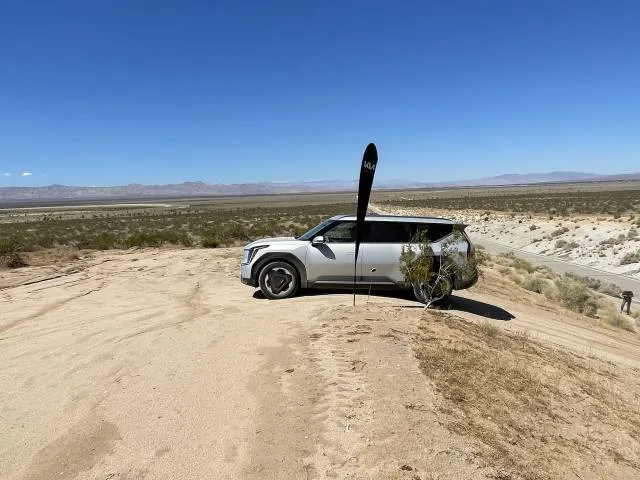
2024 Kia EV9
2024 Kia EV9: A modest off-roader
Though it’s not pitched as an off-roader, the EV9 has some off-road capability thanks to its overall design and some key features. We tested it on a mild off-road course that involved some sandy rutted paths and a run up and down a 22% grade.
For this session, Kia had us engage the 4WD Lock button on the steering wheel that splits power evenly front to rear and turns off automatically when driving over 31 mph on tarmac.
In addition to Sport, Eco, and Normal modes, the EV9 has a Snow mode and a programmable My Mode. For the sandy bit, the lead driver suggested Snow, and it did a good job of loosening up the traction control to let the tires slip and keep the momentum going. I tried Sport and Normal modes as well, and they both worked, but Snow gave me the most control.
The EV9 offers five levels of brake regeneration, labeled 0-4. The 0 setting freewheels like a gas car when letting off the throttle, and level 4 enables one-pedal driving, though the brake is still occasionally needed. When driving in Snow mode, the most regen available is level 1.
At the hill, we hit the hill descent control button on the center console, which limits the regen slightly to level 3. We also activated the forward facing camera, mostly to help see down the hill before starting off and the top of the hill when cresting it. The camera works at speeds up to 6 mph.
Even on its road-ready all-season tires, the EV9 made short work of the hill, with the front and rear tires slipping only slightly on the climb back up as they traded off traction.
The vehicle’s design gave it angles that were unchallenged by the hill. With its tires pushed out to the corners more than on a comparable gas vehicle, the EV9 has a 34.5-degree approach angle and a 40.9-degree departure angle. Both numbers are Jeep Wrangler Rubicon territory. The tradeoff is certainly a poor breakover angle that Kia hasn’t shared thus far. While it will be somewhat offset by 7.8 inches of ground clearance, the long wheelbase will give it a car-like figure and nothing like a Wrangler Rubicon. Still, the EV9 didn’t bottom out at the top of the hill, though I wouldn’t try it on a tough off-road course with peaked hills.
Though we didn’t run through any streams, the EV9 also has 19.5 inches of water fording capability.
With its design and a few features, the EV9 will perform well in the type of off-roading it will most likely do: take families off the pavement to campsites.
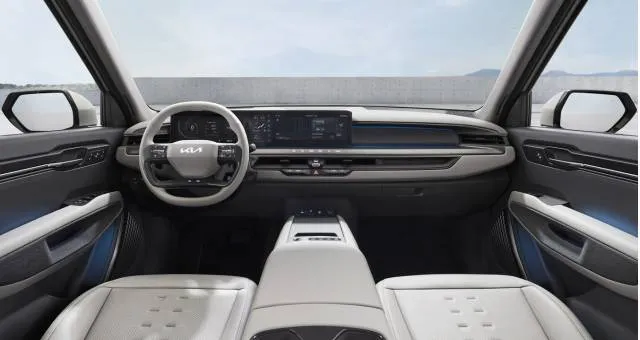
2024 Kia EV9
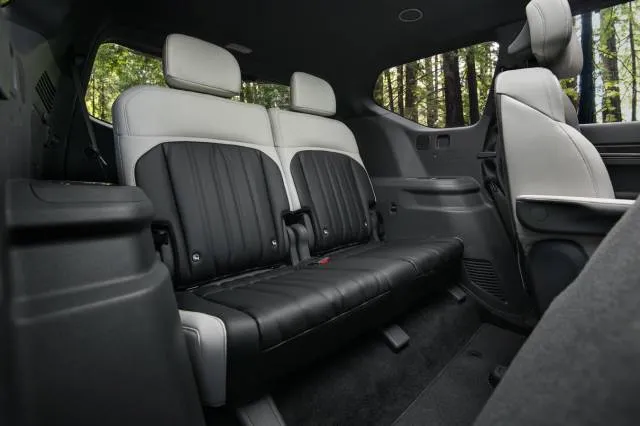
2024 Kia EV9
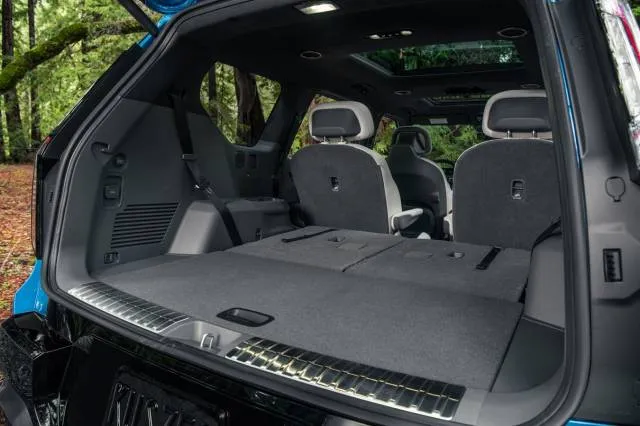
2024 Kia EV9
2024 Kia EV9: Interior impressions
In size and looks, the EV9 comes off as an electric version of the Telluride, and its interior is even more useful. It will be offered with seating configurations for six or seven passengers, depending on if buyers choose a model with the second-row bench or captain’s chairs.
Up front, the EV9 features a pair of comfortable but not overly supportive seats with good room in all dimensions, 8-way power adjustments, and standard heating and cooling in all models. In keeping with the sustainable theme of an EV, the only upholstery is synthetic leather that looks good and fits with a generally upscale interior, much like the Telluride.
The driver gets a 12.3-inch digital instrument cluster/climate control display teamed with a 12.3-inch infotainment touchscreen all under a single piece of glass. A 12.0-inch head-up display is available, and a few controls below the big screen have haptic feedback. This drive involved a variety of specific exercises, so any review of the screens will have to wait for a full test drive.
The EV9 is one of the few EVs so far that makes good use of its electric platform. At 197.4 inches, it’s a half inch shorter than the Telluride, but its 122.0-inch wheelbase is 7.8 inches longer. Combine that with an upright design, especially at the rear, and the EV9 has one of the better third rows I’ve ever sat in. It has headroom for an NBA small forward and legroom for an average-size adult. While a pair of adults will fit back there, the seat bottom is set too low for the thigh support needed for long-trip comfort.
An optional relaxation mode for the second row comes with heating, cooling, and adjustable leg rests that butt up against the front seats. The passenger side front seat can move far forward to offer more stretch out room on that side. No matter the model, every row has USB-C ports.
Cargo space checks in at 20.2 cubic feet behind the third row, 43.5 cubes behind the second row, and 81.7 cubes behind the first row, all fairly generous. There is also a small, shallow frunk with 3.2 cubic feet of space in the Light models and 1.8 cubes in the other models. It’s sized to fit a briefcase.
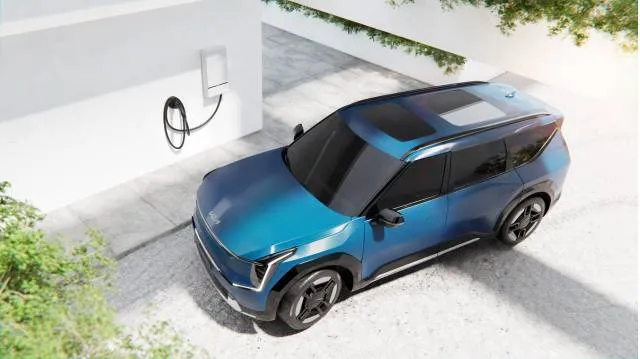
2024 Kia EV9
2024 Kia EV9: More to come
The 2024 Kia EV9 is due to hit the market later this year, but pricing hasn’t been set yet. In early Oct, Kia will start taking $1,000 reservation fees. Those buyers will get a home or portable charger, three years of scheduled maintenance, a so-far undisclosed charging credit, and some select features that can be added over the air.
The EV9 will initially be built in Korea, so it won’t qualify for the $7,500 federal tax credit. However, production will move to the U.S. about a year after launch, at which point it will qualify for the credit.
If the EV9 comes in at, say, $10,000 more than the Telluride’s pricing, which starts at $37,355 including a $1,365 destination fee, it appears that Kia will have another three-row hit on its hands thanks to its space, power, capability, efficiency, and looks.
Kia paid for travel and lodging, and gave us early access to the EV9 so The Car Connection could bring you this firsthand report.
https://www.thecarconnection.com/news/1140779_prototype-drive-2024-kia-ev9-boasts-telluride-appeal-with-ev-efficiency 2024 Kia EV9 boasts Telluride appeal with EV efficiency





